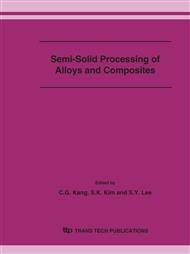p.128
p.132
p.136
p.140
p.145
p.149
p.155
p.159
p.163
Optimal Filling of Test Dies for Evaluating Properties of Semi-Solid Alloys
Abstract:
An investigative study was conducted on how two different dies designed to produce sound specimens for evaluating mechanical properties of semi-solid alloys could be filled optimally. The first die contains one cavity that produces a wedge with a sectional thickness varying from 19.05 mm (0.75 in) to 9.52 mm (0.375 in). The second die contains four cavities fed by a single runner, producing ASTM-type round bars with a diameter of 9.52 mm (0.375 in). Experiments were undertaken to cast partial and complete shots of A356 alloy test specimens under controlled injection conditions. Flow patterns developed from the moment the alloy entered the cavity were noted, including difficulties experienced in balancing flow in the four-cavity die. Microstructural abnormalities were observed in the bar specimens examined using optical and electron microscopy. It was found that control of filling and solidification in the wedge die was much easier and specimens produced did not result in any significant alloy segregation.
Info:
Periodical:
Pages:
145-148
Citation:
Online since:
October 2006
Authors:
Price:
Сopyright:
© 2006 Trans Tech Publications Ltd. All Rights Reserved
Share:
Citation:


